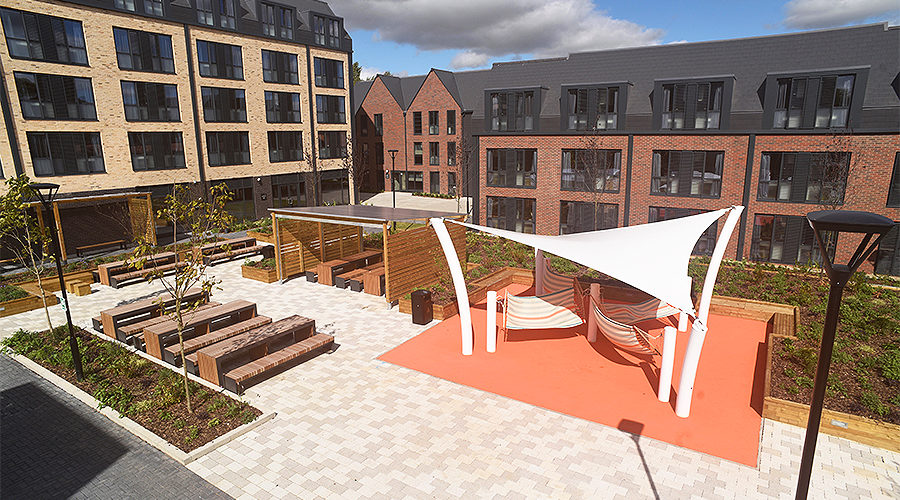Charity Make Space for Girls is calling for change after highlighting a significant gender gap in the provision of park facilities for teenage girls. Susan Johnson, Senior Business Manager at street furniture specialist Broxap, explores how councils can reimagine parks and green spaces for universal appeal.
Broxap
Girls are almost entirely designed out of park spaces – those are the findings of a citizen science project gathering data on the number of teenagers using facilities in their local parks. Research by equality charity Make Space for Girls, funded by the Sweaty Betty Foundation, shows that overall, 88% of teenagers enjoying features such
as MUGAs, skate parks and bike tracks are boys.
However, in parks where different facilities are available, such as shelters, swings and play areas designed for older children, girls are three times more likely to make use of them.
Looking at teenager facilities provided by 91 different councils as listed on their websites, the Parkwatch report showed a total of 1060 were MUGAs, 366 were skate parks and 89 were BMX tracks. There were 53 ‘other’ facilities, as well as 112 youth shelters.
Perhaps the answer to more inclusive parks lies not only in providing facilities that appeal to all genders, but in taking a fresh approach to outdoor design and delivering modern and engaging infrastructure. Parks are valued so highly because of their potential to enhance physical, mental and social wellbeing for everyone.
Municipal parks – green spaces for the public to enjoy free of charge – were first created in the 1840s in response to growing urban populations and the need for green spaces in towns amid fears of overcrowding. Today, many of these large Victorian parks still make use of traditional features such as lakes, formal flowerbeds and grassed areas for events, festivals and Sunday morning football.
Keep pace with expectations
In the centuries that followed the introduction of the first public parks, the likes of cycle paths, sculptures and fountains became commonplace. And while these historical landscapes have been updated with cafes, children’s play areas and some facilities for teenagers, it’s time to ask whether this infrastructure has kept pace with the needs and expectations of Generation Z. Or maybe more pertinently, how can sustainable infrastructure design be integrated into green spaces to prioritise health and wellbeing for all future generations?
Take the traditional bandstand, for example. Still used for concerts and celebrations, as well as a meeting point for friends or events, such as Park Run, bandstands are recognised heritage assets. Bring the concept into the 21st century, and a performance space is still entirely relevant today as many young people have personalised video feeds, and social media sharing apps are commonplace in everyday life. Including a TikTok stage or amphitheatre as part of teenage park facilities is an ideal way to appeal to a broader spectrum of park users.
The park bench is also an important amenity. Comfortable, accessible seating with scenic views across the lake may immediately spring to mind but for teenage girls, group seating may be more fitting. Think about circular bench designs, clusters of individual stools or even sunloungers and hammocks. Inspiration may even be found in other parts of the public realm or landscaped developments. Outdoor social spaces are crucial to the success of a diverse university campus – why not take some of those ideas and apply them to parks?
Parade Green student accommodation in Oxford, for example, features fabric canopies and a wide mix of outdoor furniture, including benches, tables and cube seats. The lively Slate Yard neighbourhood in Salford rates its outdoor areas as a big selling point with a stylish geometric timber canopy taking pride of place in a landscaped seating area. While classic style certainly has its place in our parks, there are endless possibilities for creating quality spaces orientated to the needs of different user groups.
Prioritise safety
Of course, providing the right spaces and equipment goes hand in hand with safe design.
Ensuring teenage girls feel safe in our parks is another key way to encourage them to make use of facilities. This can be as simple as good maintenance, ensuring parks remain well lit and litter free; holding events so that parks are busy and consistently well used; and updating signage and communications so visitors can navigate their surroundings.
The Safer Parks Consortium, which Make Space for Girls contributes to, has prepared guidance for improving park access for women and girls. It suggests a sense of belonging can directly impact safety and can help girls to feel more welcome.
For teenage girls, visible indications that a park is an inclusive space include specific facilities for that demographic like outdoor fitness equipment, MUGAs marked out for games, such as netball and volleyball as well as football and other traditional sports, and more swings and equipment for climbing and balancing.
The creation of public parks was unequivocally intended to benefit all and the enduring flexibility of green spaces is part of their beauty. From picnics to pop concerts, leisurely cricket matches to professional cycle races they provide a place for the community to connect.
Research, such as the two reports mentioned here, takes a lot of the guesswork out of the planning and preparation stages when updating facilities or designing new outdoor areas.
Working with an outdoor infrastructure partner that understands the changing demands placed on the landscape can also help local authorities to make meaningful improvements in a gender-balanced approach to futureproof parks for years to come.











